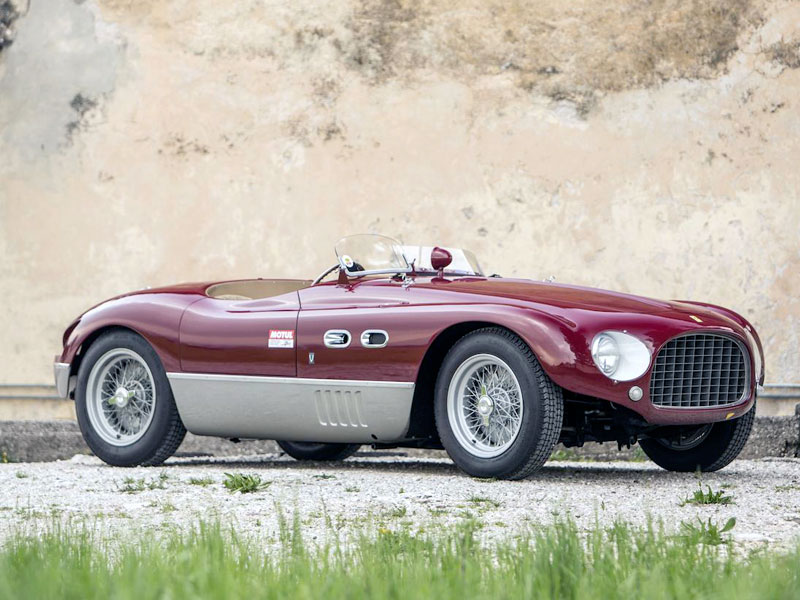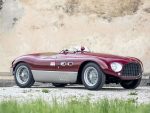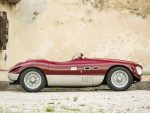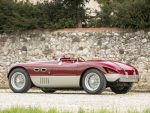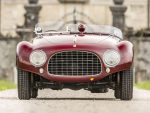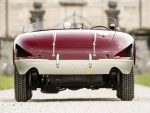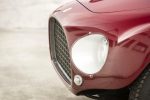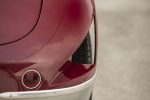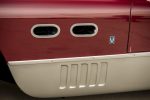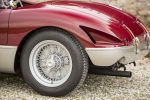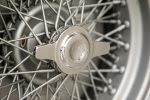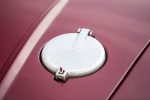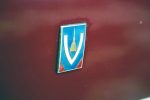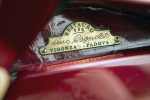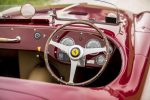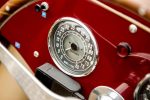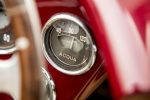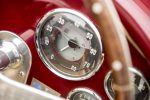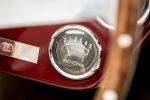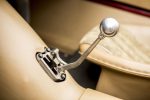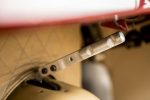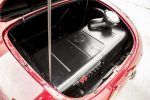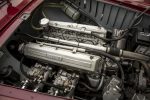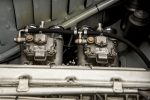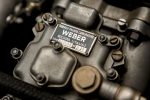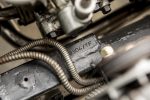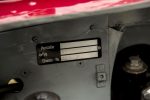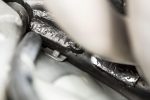ferrari 625 TF by Carrozzeria vignale – 1953
Marca : Ferrari
Modello : 625 TF
Versione : Spider
Anno : 1953
Telaio N. : 0304TF/0306TF
Motore N. : 14
Esemplari prodotti : 3
Carrozzeria : Vignale
Progettista : —
Motore : 4 cilindri in linea
Cilindrata : 2498,32 cc
Distribuzione : DOHC
Valvole Cilindro : 2
Alimentazione : 2 carburatori Weber 40 DCO4
Potenza : 220 CV a 7000 giri/min
Top speed Km/h : 240
Auction results
2018 – Monaco – Bonhams – Unsold
This Ferrari it is one of only three of the 2.5-litre 4-cylinder twin-overhead camshaft 625 Targa Florio cars to have been built, and it made its public debut on June 29, 1953, in the Autodrome Grand Prix race at Monza, Italy, driven by the Scuderia Ferrari factory team's new British recruit – and future Formula 1 World Champion -Mike Hawthorn. Bearing on that occasion race number 16, the car was driven by ‘The Farnham Flyer', as Hawthorn was known, into a fourth-place finish against strong opposition; ‘Gigi' Villoresi's 3-litre Ferrari 250MM, Felice Bonetto's Lancia D23 and the veteran World Champion Dr ‘Nino' Farina's Ferrari 250MM Vignale Spider. This result was duplicated in the second race Heat, and on aggregate overall.
Each of the three Ferrari 625 Targa Florio cars subsequently experienced a sequence of identity permutations and bodywork changes, but amongst that trio the car offered here is actually the most straightforward, with what is today probably the best understood specific history of them all, and it has a complete provenance all the way from 1953 to 2018 – 65 years, no less.
After being driven by Mike Hawthorn to that fourth-place finish at Monza, the car was fielded again by the Ferrari factory team, this time being entrusted to emerging Biellese driver Umberto Maglioli to contest the VII Coppa d'Oro delle Dolomiti – the Dolomites Gold Cup – road race around the mountains of north-eastern Italy. Bearing race number '90' the car finished third in Maglioli's highly-skilled hands.
In fact, it is considered most likely by acknowledged Ferrari in-line-engined authorities Antoine Prunet and Franco Lombardi that this particular car was based upon the very first prototype ‘works' Spider, which had been completed initially with a somewhat controversial body style hand-made by the Carrozzeria autodromo.
That body style was never favoured by Mr Ferrari himself, who regarded it as a mistake. At that time, in the Spring of 1953, the chassis of this car was almost certainly un-numbered, serving more a test and development frame which as yet was neither fully developed, nor proven.
Mr Ferrari then ordered that his more favoured sub-contractor Alfredo Vignale should be commissioned to rebody this car's chassis, to a design by his in-house Torinese stylist giovanni michelotti. It was then in this form, with the bodywork absolutely brand spanking new, and initially a 2.9-litre 4-cylinder engine, that the car was prepared and taken to Monza in time for the final practice session preceding the GP dell'Autodromo. Mike Hawthorn, its assigned driver, rushed there straight from the Rouen Grand Prix at Les Essarts in France, where he had been driving a Formula 1 625 F1 single-seater and had finished second behind Farina in a notable Ferrari 1-2 single-seater race result.
Meanwhile, the 2.9-litre engine had been transferred to Ascari's sister new Targa Florio Spider – chassis serial ‘0302TF' and had been replaced in this chassis by a 2.5-litre or ‘625' power unit.
After this initial outing, the Hawthorn Vignale Spider's nose bodywork treatment was modified, most probably by Ferrari's increasingly trusted local body specialist scaglietti, and the car reappeared with a smaller radiator air intake for the Cortina d'Ampezzo start of the Coppa d'Oro delle Dolomiti.
Umberto Maglioli promptly drove the car into its fine third place finish behind Paolo Marzotto's Ferrari 250MM Vignale Spider and the works Lancia D20 of Piero Taruffi.
Marzotto would in fact recall the 625TF thus: “I tried the 4-cylinder and I had no doubt that it could be the car to win in the Dolomites. It was light, agile and with enormous torque. On the loose surfaces of that race it was the ideal car. So, I said to Ferrari that I intended to compete with it, but there was no way of convincing him. He insisted on making me race the ‘twelve'. I got really annoyed on that occasion and I said, ‘As you like, I'll take the 12-cylinder, I'll take the lead, I'll stop 10 metres from the finish line and I'll let Taruffi pass me as he will be behind me and Maglioli.' Ferrari smiled and said, ‘You'll get to the finish line and you will not stop. You'll win ahead of Taruffi and Maglioli, I'm telling you.' He was right. I was really tempted to stop dramatically, but Ferrari knew that when a driver was there he would not give up a victory…”
Umberto Maglioli was equally impressed by this 625 Targa Florio, recalling: “It was an agile car with good handling, I was very happy with it and I aimed to win, even if Marzotto was in a state of grace. Towards the end, my engine had lost a bit of power and I had to hand second place to Taruffi, who was making his way back up the field, but it was clear that the car was good and that it would be highly suitable for the most tortuous routes.”
On July 19, 1953, Maglioli reappeared in the car at the Susa-Monte Cenisio mountain climb, but failed to finish there, after which it was sold to the Argentinean owner/driver Luis Milán.
Before being shipped to him, the car was subjected to a major factory overhaul. Antoine Prunet's searches through the Ferrari records for his forthcoming ‘Ferrari In Linea' masterwork – co-authored wth Franco Lombardi – located assembly forms referring to a 2.9-litre engine with Elektron sump and camboxes. The engine dyno test report quoted maximum output of 199.30bhp at 5,800 rpm with 168.4 kg torque at 4,000 rpm.
It appears to have been then that the car's works-period chassis serial of ‘0304TF' was amended to become ‘0306TF'. We can only assume for customs clearance purposes upon its export to Luis Milán in Argentina. In fact, as pictured here, both numbers are stamped into the chassis, in undoubtedly period strikes.
Just after Christmas of 1953, repainted in maroon with grey lower sides, and with slight bodywork modifications including an outside fuel filler and re-shaped rear air outlets, the car was shipped from Genoa to Buenos Aires, to arrive in time for the city's 1,000Kms Sports Car World Championship race on January 24, 1954. It wore Italian temporary cardboard plates bearing the registration ‘Bo 29405'.
Luis Milán, a tanner from Avellaneda, Buenos Aires, took to his new car immediately, and – co-driving it with Elpidio Tortone – he finished a most respectable fifth overall in the 1,000Kms classic.
This international success was followed by a long and active Argentine racing career in which Luis Milán finished second in the 1954 GP Otoño at Mar del Plata, fourth in the GP Invierno back in Buenos Aires, sixth in the Premio Independencia, then third in the Primavera race, and third, fourth and fifth in a series of Buenos Aires Handicap races ending that year.
Into 1955 Milán/Tortone then finished eighth in their second International Buenos Aires 1,000Kms, and Milán following up this result wth second places in the GP Anniversario at Mar del Plata and another BA Autodrome event, then eighth at Rosario. Following the Premio Invierno race, the car was likely repainted in black (on the opening panels) and yellow, then from July 1955 it was repainted in red. Third places were taken in the Invierno and Independencia races.
Milán co-drove the car with E. Capotosi in the 1956 International Buenos Aires 1,000Kms, for the first time failing to finish – retiring after 44 laps. But in the Rafaela 500-Miles Milán subsequently finished fifth, then second in the Inferno race at Buenos Aires before winning the 1956 Premio Primavera there on October 12.
Luis Milán subsequently acquired a 4.9-litre Ferrari 375-Plus in which he would become Argentine Champion, having sold ‘0304TF/0306TF' to Alvaro Piano, a Portuguese banker based in Buenos Aires. Still retaining the ‘temporary' Italian licence plate ‘Bo 29405' as issued in 1953, the ageing 625 Targa Florio would be widely campaigned by Piano in both Argentina and Brazil and would be entered twice more in Buenos Aires 1,000Kms Sports Car World Championship races, although it was a non-starter at the 1957 event and retired from the 1958 edition. In both cases Piano's co-driver was one F. Bruno. Piano's 1957 results with the car included third place in the Premio Cinquentenario in Brazil, a good third in the Rafaela 500-Miles and third again in the Primavera race at BA Autodrome.
Two fourth places were secured with the car in 1958 before the unfortunate Alvaro Piano lost his life in a flying accident. This 625Targa Florio was then acquired by rising young Argentine driver Nestor Salerno who drove it into second place in the 1959 San Carlos race at Colonia and third in the 1960 Premio 1810 at BA Autodrome, despite the elderly car's evidently increasing fragility.
By 1961 Salerno was competing in the car in Coches Special Fuerza Libre (free Formula) national races, continuing into 1962 before selling the Ferrari with two engines, a 3-litre (installed) and a spare 2.5-litre to César Rivero. He fitted the smaller unit into a speedboat which he raced successfully, while winning twice and taking three second places and two third places in Fuerza Libre racing into 1963.
After finishing third in the Campo Grande race at Asuncion, Paraguay, in May 1963, César Rivero is understood to have sold the car – by this time engineless – to enthusiast Ernesto Pablo Dillon who exchanged it with a 250GT from an Italian vendor. After years of neglect both in Argentina and Italy, to where it had been returned, the 625 Targa Florio was eventually rediscovered by Ferrari historian Franco Lombardi in a scrapyard in Naples.
He recalls: “It was around 1974/75 and I was in contact with a nice chap – Raffaele Ruggiero – a local car guy, a wheeler and dealer who had located a couple of good GT cars for me in Naples. One day I had a call: ‘Franco I have found an old racing Ferrari, a rusted sports barchetta in a local junkyard. Any interest?'. ‘Yes,' I said, ‘What kind of engine is in it?' ‘It's a V12, but it looks different from any other Ferrari V12 I've seen.' ‘OK, I'll came and have a look.”
“A few days later I landed in Naples and Raffaele was at the airport to pick me up. The car had left the junkyard and the owner had moved it to a small garage in the heart of the old town. We drove through a network of small and dirty vicoli, the colourful alleys forming the pulsing network of the local noisy life. I've lost track of Raffaele Ruggiero and will never be able to find again the little square with kids playing football where the car was. In any case, the wooden door of that small recovery finally opened and an old Ferrari Vignale sports car was rolled out.
“It was in awful condition, but its original aluminium skin was all there. Finally, we opened the hood and I could see the engine. Yes, it was a V12, but I had never heard of a side-valve V12 Ferrari… Obviously the car had ended-up with a Ford Lincoln unit inside. No number was apparently evident on its rusty chassis, but the car came with a supposed identity ‘0304TF' and a South American history.”
“I didn't buy the car – scared by the complexity of its restoration and, even for those happy days, the required price was rather stiff. It was bought later by Giuseppe Medici of Reggio Emilia.”
The new owner then entrusted this important car's restoration to various specialists around Modena. Piero Mazzetti installed a Tipo555 F1 engine located in Modena and possibly previously used to power the small-scale wind tunnel which pioneering former chief engineer carlo chiti had installed at the Maranello factory around 1960.
The bodywork was also restored by Ellis Garuti of Rubiera. Giuseppe Medici/Cevenini drove the car in the 1984 mille miglia Retro, and Medici/Bottero in the 1986 event. In May 1988 the car was sold at auction to Monaco-based British enthusiast Jeremy Agace before being acquired by Ferrari historian and renowned authority on the marque Antoine Prunet who in turn competed in the ‘Tour Auto' with his friend Gregory Noblet son of Pierre Noblet the period Ferrari racing driver. It eventually passed to its current vendor in March 2002, in whose hands ‘0304TF/0306TF' was at last given a lengthy, well-documented and meticulous restoration by respected specialist Dino Cognolato's Carrozzeria Nova Rinascente in Vigonza near Padua. Its 4-cylinder engine was overhauled by Corrado Patella, and the car was raced by its new owner a renowned private collector in a multitude of events including the Monaco Historic Grand Prix, the Mille Miglia, Le Mitiche Sport a Bassano and the Tour Auto as recently as 2016 to mention just a few.
